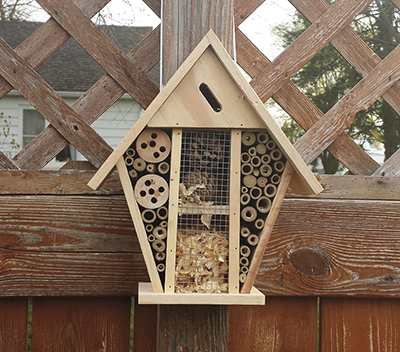
Audubon Adventures

Activities
 Activity 3
Activity 3
Bee Bundles for Native Bee Nests
 Teacher-Led Classroom/Field Activity
Teacher-Led Classroom/Field Activity
Science/Research Skills
Where do native bees nest? Does this habitat support nesting native bees?
Objective:
Students place “bee bundles” in a natural area and observe to determine if native bees use them.
Students will need:
- Paper (not plastic) drinking straws
- Clean tin cans with one end removed
- Wire
- Scissors
- Compass
Suggested time:
One class period for review and discussion and to make bee bundles. Time for two field trips to place and retrieve bee bundles.
Note: This activity must be done in early-late spring, March-May. Get permission ahead of time to leave bee bundles at the location for at least a week.
What to do:
- Review the “Buzz About Native Bees” student magazine with respect to how and where native bees nest. Discuss what kind of habitat might be best for native bees: areas with some flowering plants and other low vegetation, a mix of sun and shade, some bare ground.
- Explain that students will make artificial nests, called “bee bundles,” and place them in a natural area to see if bees will use them.
- Divide the class into small groups. Give each group a tin can and straws. Have them cut the straws to the length of the can, then pack the straws tightly into the can lengthwise. Help each group wrap the wire around the center of the can so that it will hang balanced and level on its side, leaving at least 12 inches of wire to use for hanging from a tree or bush.
- Take the class to a nearby Audubon Center, garden, park, organic farm, or even a natural area on the school grounds that is sunny, has patches of bare ground, and has a variety of trees, shrubs, and other plants.
- Explain that bees prefer to make nests that receive the morning sun, and that their nests should be 3 to 5 feet off the ground. Use the compass to determine which direction is east. Allow students 15-20 minutes to observe the area and choose a spot for their bee bundles.
- Have each group hang its bee bundle from a low tree limb or shrub with the open end facing east. Ask them to draw a simple map to record the location of the bundles.
- After at least a week, return to the area to inspect and/or retrieve the bee bundles. Did native bees use them? How can you tell? (You can see a brood chamber inside a straw.) Discuss the locations of the bundles that bees used and possible reasons.
Extension:
Adult bees will not emerge until the following spring. You might be able to get permission to leave the bee bundles in place until then. You can also store them together outside in a protected area.
For variations and additional information, visit these websites:
http://www.xerces.org/wp-content/uploads/2008/11/
nests_for_native_bees_fact_sheet_xerces_society.pdf
https://www.beelab.umn.edu/sites/beelab.umn.edu/files/cfans_asset_486207.pdf
Photos: Dan Mullen; Anne Heathen/Flickr CC by 2.0.




